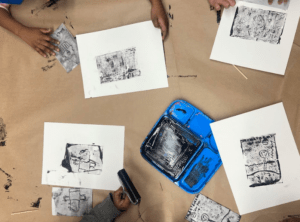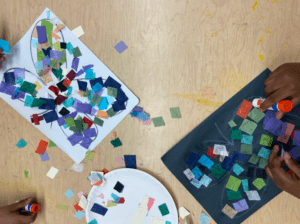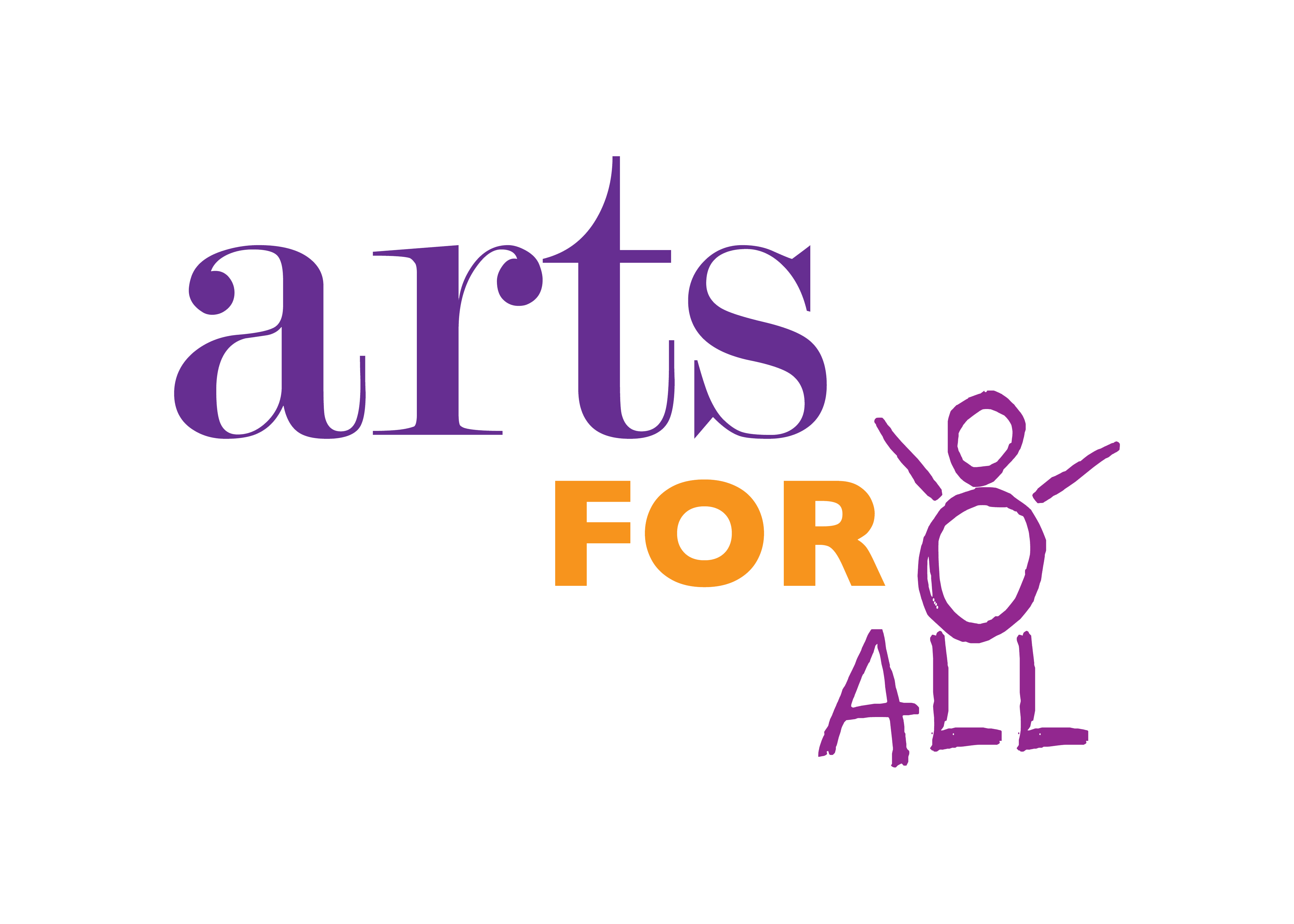Written by AFA Spring 2023 Intern Melody Fay Browning
February 2nd, 2023

Photo By Melody Fay Browning
On Thursday, February 2nd I had the pleasure of joining teaching artist Ciara Ruddock for three classes at PS 243. Each group was happy and excited to welcome me into the room. Ciara told me they love guests, and I definitely felt their warm welcome. To start off each class, Ciara passed around a hand mirror covered in pink gems and asked each student to look at themselves and say one thing that they love about themselves. Some of the students were shy, and I could tell they felt a bit awkward about complimenting themselves out loud, but once everyone got past the initial awkwardness of doing something out of the ordinary, it was so heartwarming to see them name the things they love about themselves and express self-love. Next Ciara got started on the class’s art project, which was print making. She demonstrated how the class would use a stylus and a piece of foam to draw and make a stamp that we would then cover with paint and stamp onto a large piece of paper. The classes were all very eager to try this out and came up with their own ideas about what to put on the stamp. Many chose simple shapes, but some chose hearts and flowers because Valentine’s Day is approaching. Some others also chose to continue with the self-love theme and came up with images that represented parts of themselves or did self-portraits. It took some trial and error for many of the children to figure out how much paint exactly was ideal to make their stamps the most effective, which caused some frustration at times, but eventually the classes all figured it out and created their unique prints. It was so fun to go around the room and talk to each student about their piece, as they all had created very specific images including things they loved.
Teaching Artist Ciara Ruddock Interview Part 1:
Q: What factors do you think about when developing your lesson plans?
Ciara: When developing lesson plans it is important to me to factor in the culture and values of the particular students I am working with whenever possible. Often this understanding comes with time spent getting to know students and their interests, so that often means a consistent editing and shifting in what I have planned from week to week. Another important factor is prior knowledge, access, and comfortability with self-expression, which is again, information that is learned over time. When planning I tend to scaffold and always keep at least one alternate route in my back pocket so that I can ensure I am meeting students where they are at, rather than where I imagine them to be. I try to remove my bias in planning as much as possible (which is always a work in progress).
Q: How do you navigate classrooms with children that are at different levels of learning and skill?
Ciara: This relates back to the idea of scaffolding. No matter what the lesson is that I am presenting, I make sure that I have modifications and options to reach as many students as possible. That being said, I am a huge proponent of peer-to-peer learning. If there is a classroom with distinct differences in levels, I will often pair students together to skill share. Bonus – through this, Social Emotional Learning is also incorporated. Working together helps to teach collaboration, cooperation and compassion.
Q: What do you hope children in your classes take away from your lessons?
Ciara: My main purpose in all that I do is to show young people that self-expression is an act of self-love, and in knowing that, we honor and value the process of art alone. I hope to teach young people that the product is nothing but a souvenir of their journey in creation, and to find joy in all that leads up to that.
March 2nd, 2023

Photo By Melody Fay Browning
On Thursday, March 2nd I had the pleasure of joining teaching artist Ciara Ruddock for three different classes at PS 243. Each group had a very excited energy, and it was clear they were all ready and excited for art time. Ciara started the class by talking about the word joy. She asked the class for the definition of the word, and most agreed it meant something like happy or excited. Ciara then asked the class to go around and share one thing that brought them joy. Most of the kids mentioned either their family or their favorite TV show. Ciara then introduced the art project for the day, which was a collage butterfly, because butterflies are sometimes a symbol of joy. The children were tasked with using a glue stick and small pieces of paper to fill in a butterfly shape on a piece of paper and then cutting the butterfly shape out to reveal their finished art pieces. Each child has their own unique idea about how to make the collage and what colors they wanted to use. They all turned out very fun and colorful and the classes had a great time making them. It was so fun to see the amount of detail and focus the children had to create their collages exactly as they imagined them.
Teaching Artist Ciara Ruddock Interview Part 2:
Q: I really loved the art that the children made during your lessons. What contributes to how you choose a project for any given class? Are there specific skills you want to develop? Or themes you want to explore?
Ciara: In all honesty, most projects are usually contingent upon the supplies we have access to. There is a vast budget for supplies, so the reality is that a lot of things get scaled down or changed at the last minute. The foundation of every experience for me is teaching students how to embrace the unknown and celebrate their imagination – so I try my best to teach them multiple ways to use a single tool (like a crayon for example) to work the muscles of the imagination as best I can, even if resources are limited.
Q: When I visited your classes, I really loved the check-ins you did at the beginning of the class and how they focused on self-love. Why do you think these check-ins are important?
Ciara: We are living in a difficult time to say the least, and the public education system is pressing forward without acknowledging the trauma of the past 3 years. Students and teachers alike hold this in our bodies and though I cannot truly disrupt the system in my role – I feel that making space for emotional understanding and awareness can serve as a way of validating the pain and trauma that we all collectively feel. Exercises like this also help to build trust amongst students, and with adults in their room. To create safe spaces to share feelings without judgment plants the seed of vulnerability – something I believe has been pushed aside in service of the system.
Q: I really liked what you said in one of your answers to my previous questions about how the end product is “nothing but a souvenir of their journey in creation.” I think it’s so important for children experiencing the arts to be focused on process rather than product. Can you talk a little about how you keep your lessons focused on process rather than product?
Ciara: I’ve learned that an effect of the pandemic seems to be that young people require more structure at present – whereas in years prior to 2020 open ended lessons were easier for a wider range of students to access. I share this to say that finding ways to centralize process, while still maintaining structure and clarity, has been a challenge of this school year in particular. The school you observed is a special case in my experience. They seem to be an outlier, with a wonderful art teacher, who provided them with the basics and foundations of art before I arrived. These students naturally gravitate towards process based making and often don’t even care to save their work – they are truly interested in the experience of making for the most part. At other schools I work with currently this is not the case, I find myself scaffolding highly instructional lessons slowly over time to get students in a place where they feel confident enough to enjoy the process and not focus on the product. Sometimes we get there, and sometimes there is a great deal of frustration.
